Abstract
The brain tumor glioblastoma (GBM) remains one of the most aggressive and devastating tumors despite decades of effort to find more effective treatments. A hallmark of GBM is the constitutive activation of the nuclear factor kappa-light-chain-enhancer of activated B cells (NF-κB) signaling pathway, which regulates cell proliferation, inflammation, migration and apoptosis. The prolyl isomerase, Pin1, has been found to bind directly to the NF-κB protein, p65, and cause increases in NF-κB promoter activity in a breast cancer model. We now present evidence that this interaction occurs in GBM and that it has important consequences on NF-κB signaling. We demonstrate that Pin1 levels are enhanced in primary GBM tissues compared with controls, and that this difference in Pin1 expression affects the migratory capacity of GBM-derived cells. Pin1 knockdown decreases the amount of activated, phosphorylated p65 in the nucleus, resulting in inhibition of the transcriptional program of the IL-8 gene. Through the use of microarray, we also observed changes in the expression levels of other NF-κB regulated genes due to Pin1 knockdown. Taken together, these data suggest that Pin1 is an important regulator of NF-κB in GBM, and support the notion of using Pin1 as a therapeutic target in the future.
This is a preview of subscription content, access via your institution
Access options
Subscribe to this journal
Receive 50 print issues and online access
$259.00 per year
only $5.18 per issue
Buy this article
- Purchase on Springer Link
- Instant access to full article PDF
Prices may be subject to local taxes which are calculated during checkout







Similar content being viewed by others
References
Aggarwal BB . (2004). Nuclear factor-kappaB: the enemy within. Cancer Cell 6: 203–208.
Ayala G, Wang D, Wulf G, Frolov A, Li R, Sowadski J et al. (2003). The prolyl isomerase Pin1 is a novel prognostic marker in human prostate cancer. Cancer Res 63: 6244–6251.
Baker BJ, Qin H, Benveniste EN . (2008). Molecular basis of oncostatin M-induced SOCS-3 expression in astrocytes. Glia 56: 1250–1262.
Bao L, Kimzey A, Sauter G, Sowadski JM, Lu KP, Wang DG . (2004). Prevalent overexpression of prolyl isomerase Pin1 in human cancers. Am J Pathol 164: 1727–1737.
Bharti AC, Aggarwal BB . (2002). Nuclear factor-kappa B and cancer: its role in prevention and therapy. Biochem Pharmacol 64: 883–888.
Brandes AA, Tosoni A, Franceschi E, Reni M, Gatta G, Vecht C . (2008). Glioblastoma in adults. Crit Rev Oncol Hematol 67: 139–152.
Brantley EC, Nabors LB, Gillespie GY, Choi YH, Palmer CA, Harrison K et al. (2008). Loss of protein inhibitors of activated STAT-3 expression in glioblastoma multiforme tumors: implications for STAT-3 activation and gene expression. Clin Cancer Res 14: 4694–4704.
Brat DJ, Bellail AC, Van Meir EG . (2005). The role of interleukin-8 and its receptors in gliomagenesis and tumoral angiogenesis. Neuro-oncol 7: 122–133.
Chandana SR, Movva S, Arora M, Singh T . (2008). Primary brain tumors in adults. Am Fam Physician 77: 1423–1430.
Choi C, Kutsch O, Park J, Zhou T, Seol DW, Benveniste EN . (2002). Tumor necrosis factor-related apoptosis-inducing ligand induces caspase-dependent interleukin-8 expression and apoptosis in human astroglioma cells. Mol Cell Biol 22: 724–736.
Choi YH, Bernardi R, Pandolfi PP, Benveniste EN . (2006). The promyelocytic leukemia protein functions as a negative regulator of IFN-gamma signaling. Proc Natl Acad Sci USA 103: 18715–18720.
Finn G, Lu KP . (2008). Phosphorylation-specific prolyl isomerase Pin1 as a new diagnostic and therapeutic target for cancer. Curr Cancer Drug Targets 8: 223–229.
Garkavtsev I, Kozin SV, Chernova O, Xu L, Winkler F, Brown E et al. (2004). The candidate tumour suppressor protein ING4 regulates brain tumour growth and angiogenesis. Nature 428: 328–332.
Ghosh S, Karin M . (2002). Missing pieces in the NF-kappaB puzzle. Cell 109: S81–S96.
Gilmore T . (2008). Boston: MA. www.NF-kB.org, <http://people.bu.edu/gilmore/nf-kb/index.html>.
Greten FR, Eckmann L, Greten TF, Park JM, Li ZW, Egan LJ et al. (2004). IKKbeta links inflammation and tumorigenesis in a mouse model of colitis-associated cancer. Cell 118: 285–296.
Harant H, de Martin R, Andrew PJ, Foglar E, Dittrich C, Lindley IJ . (1996). Synergistic activation of interleukin-8 gene transcription by all-trans-retinoic acid and tumor necrosis factor-alpha involves the transcription factor NF-kappaB. J Biol Chem 271: 26954–26961.
Hayden MS, Ghosh S . (2004). Signaling to NF-kappaB. Genes Dev 18: 2195–2224.
Hayden MS, Ghosh S . (2008). Shared principles in NF-kappaB signaling. Cell 132: 344–362.
Hoffmann A, Leung TH, Baltimore D . (2003). Genetic analysis of NF-kappaB/Rel transcription factors defines functional specificities. EMBO J 22: 5530–5539.
Hoffmann A, Levchenko A, Scott ML, Baltimore D . (2002a). The I-kappaB–NF-kappaB signaling module: temporal control and selective gene activation. Science 298: 1241–1245.
Hoffmann E, Dittrich-Breiholz O, Holtmann H, Kracht M . (2002b). Multiple control of interleukin-8 gene expression. J Leukoc Biol 72: 847–855.
Jang HD, Yoon K, Shin YJ, Kim J, Lee SY . (2004). PIAS3 suppresses NF-/{kappa/}B-mediated transcrip. J Biol Chem 279: 24873–24880.
Karin M . (2006). Nuclear factor-kappaB in cancer development and progression. Nature 441: 431–436.
Karin M, Cao Y, Greten FR, Li ZW . (2002). NF-kappaB in cancer: from innocent bystander to major culprit. Nat Rev Cancer 2: 301–310.
Karin M, Lin A . (2002). NF-kappaB at the crossroads of life and death. Nat Immunol 3: 221–227.
Li S, Wang L, Berman MA, Zhang Y, Dorf ME . (2006). RNAi screen in mouse astrocytes identifies phosphatases that regulate NF-kappaB signaling. Mol Cell 24: 497–509.
Lu KP . (2003). Prolyl isomerase Pin1 as a molecular target for cancer diagnostics and therapeutics. Cancer Cell 4: 175–180.
Lu KP, Zhou XZ . (2007). The prolyl isomerase PIN1: a pivotal new twist in phosphorylation signalling and disease. Nat Rev Mol Cell Biol 8: 904–916.
Lufei C, Koh TH, Uchida T, Cao X . (2007). Pin1 is required for the Ser727 phosphorylation-dependent Stat3 activity. Oncogene 26: 7656–7664.
Nagai S, Washiyama K, Kurimoto M, Takaku A, Endo S, Kumanishi T . (2002). Aberrant nuclear factor-kappaB activity and its participation in the growth of human malignant astrocytoma. J Neurosurg 96: 909–917.
Nozell S, Laver T, Moseley D, Nowoslawski L, Devos M, Atkinson GP et al. (2008). The ING4 tumor suppressor attenuates NF-/{kappa/}B activity at the promoter of target genes. Mol Cell Biol 28: 6632–6645.
Nozell S, Laver T, Patel K, Benveniste EN . (2006). Mechanism of IFN-beta-mediated inhibition of IL-8 gene expression in astroglioma cells. J Immunol 177: 822–830.
Nozell S, Ma Z, Wilson C, Shah R, Benveniste EN . (2004). Class II major histocompatibility complex transactivator (CIITA) inhibits matrix metalloproteinase-9 gene expression. J Biol Chem 279: 38577–38589.
Pang R, Lee T, Man K, Poon R, Fan ST, Kwong YL et al. (2006). PIN1 expression contributes to hepatic carcinogenesis. J Pathol 210: 19–25.
Perkins ND . (2006). Post-translational modifications regulating the activity and function of the nuclear factor kappa B pathway. Oncogene 25: 6717–6730.
Raychaudhuri B, Han Y, Lu T, Vogelbaum MA . (2007). Aberrant constitutive activation of nuclear factor kappaB in glioblastoma multiforme drives invasive phenotype. J Neurooncol 85: 39–47.
Ryo A, Hirai A, Nishi M, Liou YC, Perrem K, Lin SC et al. (2007). A suppressive role of the prolyl isomerase Pin1 in cellular apoptosis mediated by the death-associated protein Daxx. J Biol Chem 282: 36671–36681.
Ryo A, Liou YC, Wulf G, Nakamura M, Lee SW, Lu KP . (2002). PIN1 is an E2F target gene essential for Neu/Ras-induced transformation of mammary epithelial cells. Mol Cell Biol 22: 5281–5295.
Ryo A, Suizu F, Yoshida Y, Perrem K, Liou YC, Wulf G et al. (2003). Regulation of NF-kappaB signaling by Pin1-dependent prolyl isomerization and ubiquitin-mediated proteolysis of p65/RelA. Mol Cell 12: 1413–1426.
Ryo A, Uemura H, Ishiguro H, Saitoh T, Yamaguchi A, Perrem K et al. (2005). Stable suppression of tumorigenicity by Pin1-targeted RNA interference in prostate cancer. Clin Cancer Res 11: 7523–7531.
Saccani S, Pantano S, Natoli G . (2001). Two waves of nuclear factor kappaB recruitment to target promoters. J Exp Med 193: 1351–1359.
Smith D, Shimamura T, Barbera S, Bejcek BE . (2007). NF-kappaB controls growth of glioblastomas/astrocytomas. Mol Cell Biochem 307: 141–147.
Stewart LA . (2002). Chemotherapy in adult high-grade glioma: a systematic review and meta-analysis of individual patient data from 12 randomised trials. Lancet 359: 1011–1018.
Strieter RM, Burdick MD, Mestas J, Gomperts B, Keane MP, Belperio JA . (2006). Cancer CXC chemokine networks and tumour angiogenesis. Eur J Cancer 42: 768–778.
Stupp R, Dietrich P-Y, Kraljevic SO, Pica A, Maillard I, Maeder P et al. (2002). Promising survival for patients with newly diagnosed glioblastoma multiforme treated with concomitant radiation plus temozolomide followed by adjuvant temozolomide. J Clin Onc 20: 1375–1382.
Vila-Carriles WH, Kovacs GG, Jovov B, Zhou ZH, Pahwa AK, Colby G et al. (2006). Surface expression of ASIC2 inhibits the amiloride-sensitive current and migration of glioma cells. J Biol Chem 281: 19220–19232.
Wakabayashi K, Kambe F, Cao X, Murakami R, Mitsuyama H, Nagaya T et al. (2004). Inhibitory effects of cyclosporin A on calcium mobilization-dependent interleukin-8 expression and invasive potential of human glioblastoma U251MG cells. Oncogene 23: 6924–6932.
Wang H, Zhang W, Huang HJ, Liao WS, Fuller GN . (2004). Analysis of the activation status of Akt, NFkappaB, and Stat3 in human diffuse gliomas. Lab Invest 84: 941–951.
Wulf GM, Ryo A, Wulf GG, Lee SW, Niu T, Petkova V et al. (2001). Pin1 is overexpressed in breast cancer and cooperates with Ras signaling in increasing the transcriptional activity of c-Jun towards cyclin D1. EMBO J 20: 3459–3472.
Xu YX, Manley JL . (2007). Pin1 modulates RNA polymerase II activity during the transcription cycle. Genes Dev 21: 2950–2962.
Yamamoto M, Fukushima T, Hayashi S, Ikeda K, Tsugu H, Kimura H et al. (2000). Correlation of the expression of nuclear factor-kappa B, tumor necrosis factor receptor type 1 (TNFR 1) and c-Myc with the clinical course in the treatment of malignant astrocytomas with recombinant mutant human tumor necrosis factor-alpha (TNF-SAM2). Anticancer Res 20: 611–618.
Yeh ES, Means AR . (2007). PIN1, the cell cycle and cancer. Nat Rev Cancer 7: 381–388.
Zhong H, May MJ, Jimi E, Ghosh S . (2002). The phosphorylation status of nuclear NF-kappa B determines its association with CBP/p300 or HDAC-1. Mol Cell 9: 625–636.
Zhong H, Voll RE, Ghosh S . (1998). Phosphorylation of NF-kappa B p65 by PKA stimulates transcriptional activity by promoting a novel bivalent interaction with the coactivator CBP/p300. Mol Cell 1: 661–671.
Acknowledgements
We thank Dr Michael Crowley in the UAB Comprehensive Cancer Center Gene Expression Shared Facility for his assistance with microarray processing, and Dr Cheryl Ann Palmer (University of Alabama at Birmingham) for providing the brain tumor resections. We also thank Dr Yancey Gillespie, UAB Brain Tumor Tissue Core, for glioma and control tissue samples, and express our appreciation to the laboratory of Dr Dale Benos for assistance with the scratch assay. Finally, many thanks to Dr Rafal Bartoszewski for assistance with the qPCR and to Dr Gerald Fuller for reading the paper. This work was supported in part by National Institutes of Health grants CA-97247 (ENB), NS-54158 (ENB and SEN) and IRG-60-001-47 from the American Cancer Society and CA-13148-31 from the NCI (SEN). GPA was supported by the UAB Medical Scientist Training Program, and is currently supported by NIH T32-AI0705.
Author information
Authors and Affiliations
Corresponding author
Rights and permissions
About this article
Cite this article
Atkinson, G., Nozell, S., Harrison, D. et al. The prolyl isomerase Pin1 regulates the NF-κB signaling pathway and interleukin-8 expression in glioblastoma. Oncogene 28, 3735–3745 (2009). https://doi.org/10.1038/onc.2009.232
Received:
Revised:
Accepted:
Published:
Issue Date:
DOI: https://doi.org/10.1038/onc.2009.232
Keywords
This article is cited by
-
Deficiency of microRNA-628-5p promotes the progression of gastric cancer by upregulating PIN1
Cell Death & Disease (2020)
-
Prolyl isomerase Pin1: a promoter of cancer and a target for therapy
Cell Death & Disease (2018)
-
MicroRNA-140-5p inhibits hepatocellular carcinoma by directly targeting the unique isomerase Pin1 to block multiple cancer-driving pathways
Scientific Reports (2017)
-
Prolyl isomerase PIN1 regulates the stability, transcriptional activity and oncogenic potential of BRD4
Oncogene (2017)
-
Sensitizing effect of juglone is mediated by down regulation of Notch1 signaling pathway in trastuzumab-resistant SKBR3 cells
Apoptosis (2017)



